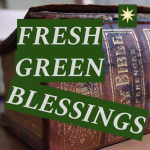
Genesis 37: 23-28, 31-34 (KJV): And it came to pass, when Joseph was come unto his brethren, that they stript Joseph out of his coat, his coat of many colours that was on him; And they took him, and cast him into a pit: and the pit was empty, there was no water in it. And they sat down to eat bread: and they lifted up their eyes and looked, and, behold, a company of Ishmeelites came from Gilead with their camels bearing spicery and balm and myrrh, going to carry it down to Egypt. And Judah said unto his brethren, “What profit is it if we slay our brother, and conceal his blood? Come, and let us sell him to the Ishmeelites, and let not our hand be upon him; for he is our brother and our flesh.” And his brethren were content. Then there passed by Midianites merchantmen; and they drew and lifted up Joseph out of the pit, and sold Joseph to the Ishmeelites for twenty pieces of silver: and they brought Joseph into Egypt…And [the brothers] took Joseph’s coat, and killed a kid of the goats, and dipped the coat in the blood; And they sent the coat of many colours, and they brought it to their father; and said, “This have we found: know now whether it be thy son’s coat or no.” And he knew it, and said, “It is my son’s coat; an evil beast hath devoured him; Joseph is without doubt rent in pieces.” And Jacob rent his clothes, and put sackcloth upon his loins, and mourned for his son many days.
∞∞∞∞∞∞∞∞
Previously, in Genesis 27, Jacob, with assistance from his mother Rebekah, tricked his father Isaac into giving Jacob the blessing that had been intended for his elder brother Esau. Esau was a hairy man so Jacob tricked his blind, dying father into thinking that he was really Esau by wearing goat-skin gloves.
It is a generation later in Genesis Chapter 37, Jacob is now the elder. The trickster son has become the tricked father. Jacob’s sons, after thinking about killing their favored brother Joseph, instead toss him into a pit and later sell him as a slave to the despised Ishmaelites. Returning home without Joseph, the brothers have doused Joseph’s multi-colored robe (made famous in modern times by Andrew Lloyd Webber’s Joseph and the Technicolor DreamCoat) in goat’s blood. They return the besmeared coat to their father saying they found this and presume their brother was killed.
The father is tricked with a sacrificed goat by the deceit of one or more sons because of their harsh sibling conflict.
For Jacob, we might think of the karma of his own deception returning – biting him back for his own goat-infested lies to his father. More generally, we will see that motifs come around again and again as we delve ever more deeply into Biblical tales and teachings. There is a circling, swirling helix of themes and problems and words and symbols. There are even additional layers of the coil in this particular story: the Ishmaelites who buy Joseph as a slave are the descendants of Ishmael. This adds another layer to the circle of ancestral sibling tension because Ishmael was Abraham’s excluded son, the elder half-brother of Isaac. The Bible stories swirl and whirl in circling convolutions of repetition and complexity.
Ecotheology invites a non-linear approach to the Divine. The cosmos shows us that the Sacred has created a world of revolving orbs and orbiting spheres. Spinning and circling round again and again seem inherent to the natural order. Our spiritual and religious growth mirrors the seasons. Spring comes around again. There are blossoms on the cherry tree again. This year there is a fine crop. A late frost killed the blossoms last year. Things are the same. They are not the same. Such is the nature of ritual and tradition and seasons and the helix of Biblical stories.
To impose a linear theology on the Bible is to deny the helix. There are reasons that slaves in North America could recognize and be inspired by Moses and the Israelites freedom from bondage centuries before. There are reasons why stories and psalms and teachings from past millenia can still sway us, offend us, hearten and embolden us. Ecotheology and ecospirituality invite us to ride this helix of learning and unlearning – of inspiration and frustration and being inspired once more. The Bible invites us into the sacred helix of growth.
∞∞∞∞∞∞∞∞
As you spend time with the Bible, note words, themes, relations, symbols, emotions that surface again and again. Stories and words and ideas circle and twirl, loop and intermingle in webs of meaning and confusion that create an ever-changing kaleidoscope of color and contour. Some of this is fairly obvious (and often pointed out in Biblical footnotes) as when Jesus quotes one of the old Hebrew prophets or draws from a specific psalm, but much of it is hidden, waiting for your discovery. Pick two very different books of the Bible and read them simultaneously, reading a chapter of each one each day. Practice ecotheology. See if new spirals of meaning surface.
(Music: Courtesy of Adrian Von Ziegler, “Circle of Life.” )